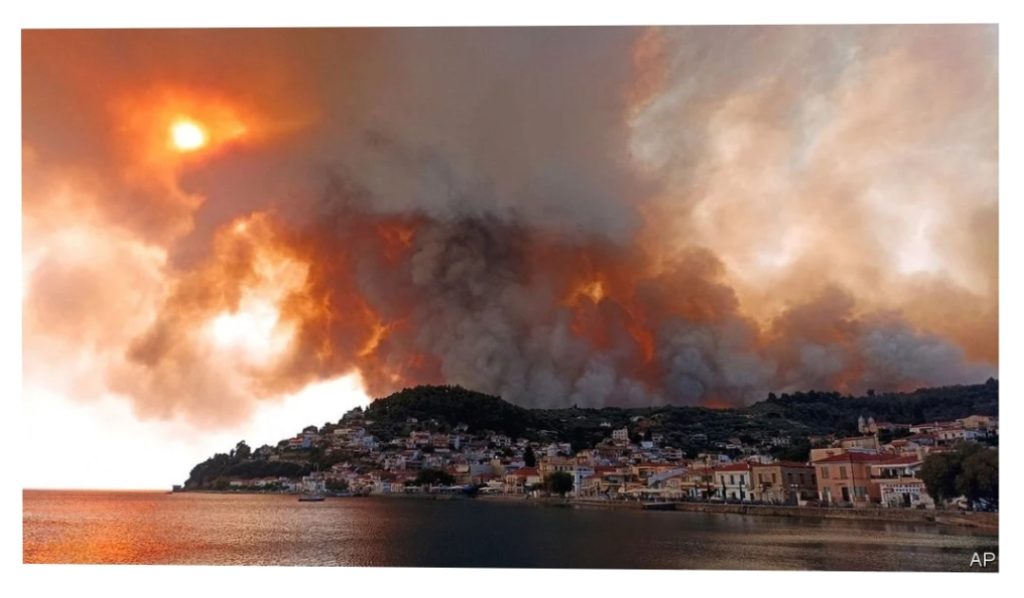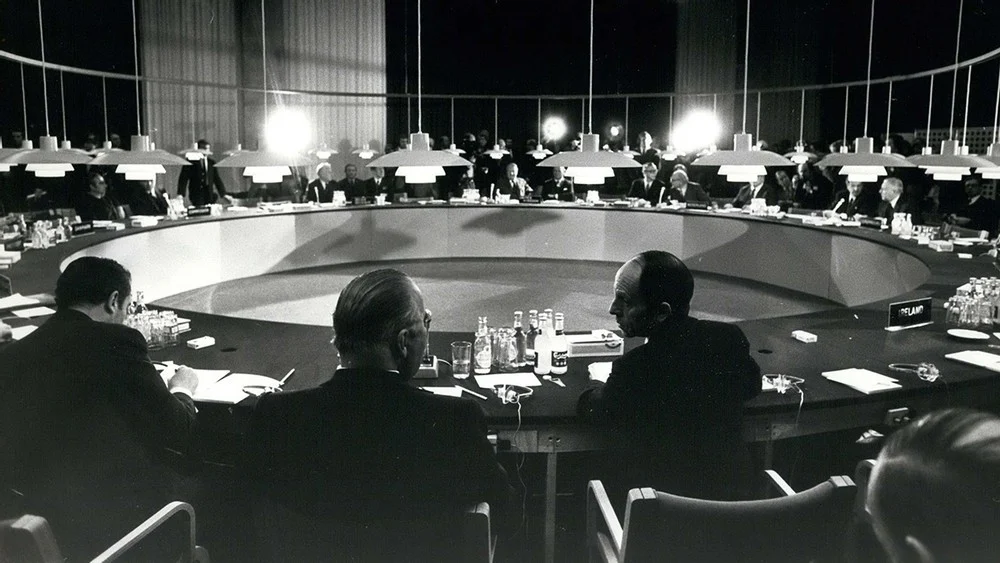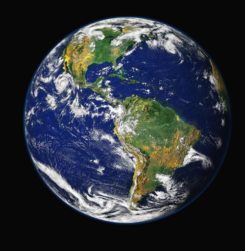AT A KEY moment in the film “Jaws”, police chief Martin Brody, having known that a shark attack was possible, witnesses one actually happen. The director, Stephen Spielberg, underlines the transformative nature of Brody’s shock with a shot which makes inspired use of a camera technique called a “dolly zoom”. Nothing on screen actually moves. But Brody’s guilty face seems to rush towards the audience, taking up more and more of the frame. At the same time his surroundings, rather than being displaced, are revealed more fully.
The report released by the Intergovernmental Panel on Climate Change on August 9th, the first part of the IPCC’s sixth assessment report (AR6), presents the spectacle of the possible becoming actual in a similarly unnerving way. The focus on the risk of continued warming makes it starker than ever before; meanwhile the detail with which the changes already under way can now be seen broadens the context in which that challenge is seen.
The oncoming dread registers yet more clearly than it did in the IPCC’s previous major assessment, AR5, published in 2013-14. The Earth has warmed over a tenth of a degree since then; it is now approximately 1.1ºC (2ºF) hotter than it was in the second half of the 19th century. Even if the countries of the world cut their greenhouse-gas emissions dramatically (they are not yet on a consistent downward trend of any sort) the IPCC finds that temperatures are very likely to be 1.5ºC higher than they were in the 19th century by 2050—if not before. That breaks the more ambitious of the goals for limiting climate change that the world signed up to in the Paris agreement of 2015.
One of the big steps in climate science to which the IPCC gave its imprimatur last time round was the idea that the amount the Earth will heat up depends pretty closely on cumulative greenhouse-gas emissions and that this allows the “carbon budget” associated with various temperatures to be calculated. For AR6 this budgeting has been carried through again. The budget associated with a 50:50 chance of staying below 1.5ºC allows just 500bn more tonnes of carbon dioxide to be emitted. That is about 15 years of industrial emissions at current rates (emissions from deforestation make things worse). For that to be all that is ever emitted would require the whole world, not just developed countries, to be at net-zero before 2050.
At the same time as laying out the increased difficulty of meeting that central challenge, the report also shows how much more science can now say about the nature of the change under way—providing a fuller context. It is much more assertive than its predecessors in terms of attributing changes and specific events to climate change, describing the distribution of these effects around the Earth and assessing the degree to which the weather is being pushed to new extremes.
The report’s 234 authors base these conclusions, in a phrase that acts as something of a refrain, on “multiple lines of evidence”: not just the output of computer models but also on an improved physical understanding of various physical processes involved and, crucially, on observations of the way in which the world has changed so far. The authors stress that such changes are now “affecting every inhabited region across the globe, with human influence contributing to many observed changes in weather and climate extremes”.
The IPCC’s assessments represent massive commitments of time and effort on the part of researchers around the world. Each assessment consists of huge volumes produced by three different working groups; one looks at the current state of the physical science of climate change, the second assesses research on impacts, vulnerability and adaptation, and the third looks at what is known about the possibilities of mitigation. The release of the different working groups’ reports is typically staggered over a year or so; the salvo just released is Working Group I’s report on the physical science.
A crucial part of this document is the “summary for policymakers”, which is, to some extent, also a summary by policymakers. During a five-day plenary process which ended on August 6th the governments that are part of the IPCC worked through a draft summary prepared by the scientific authors to produce a text on which all could agree. In the past this process has sometimes been vexed, with some governments unwilling to see things they found politically troubling expressed as bluntly as the scientists wished. On this occasion, though, the governments’ editing prerogatives were mainly used to ensure the inclusion of language various parties wanted in order subtly to bolster the negotiating positions they intend to take at COP26, the UN climate conference which will take place in Glasgow this November.
This easy passage probably reflects the extent to which the report assembled by the scientists shows a new level of assurance about its conclusions. The statements in the summary in which the authors express “high confidence” handily outnumber those in which they have only “medium confidence”; in the previous report the two were level pegging. Areas where there is high confidence which was lacking before include the idea that human influence has increased the frequency of concurrent heatwaves and droughts worldwide; that heavy rainfall and flooding will be both more frequent and more intense in most of Asia and Africa at 1.5ºC; and that some mid-latitude regions, including south, central and eastern Europe, are projected to see the highest increase in the temperature of the hottest days, at about 1.5 to 2 times the rate of global warming.
Another important increase in confidence is seen in the report’s estimate of the “equilibrium climate sensitivity”—the amount of warming to be expected as a result of a doubling of the carbon-dioxide level. In 2007’s AR4, this number was put between 2 and 4.5ºC; in 2013’s AR5 the uncertainty had increased slightly, expanding the range to 1.5-4.5ºC (range 3). Now it has been halved: AR6 puts the sensitivity at 2.5-4ºC, with a best estimate of 3ºC.
Part of the higher confidence is down to better science, which is always welcome. Another part is down to bitter experience, which is not. In almost every part of its summary the report stresses that the world is now living through climate change, not watching it draw near. Hence the “multiple lines of evidence” which go beyond modelling and theory to observation of what has happened in recent decades.
There is, for those who see glasses as half full, some good news. The report finds that large-scale carbon-dioxide removal from the atmosphere might indeed be a way of reducing temperatures. Since policymakers have become increasingly reliant on such removals as the only way of reconciling the modest near-term cuts they are actually delivering with the dramatic long-term ambitions they proclaim, this is just as well. If the IPCC had found large-scale carbon-dioxide removal entirely untenable that would have put the kibosh on the whole idea of targeting “net-zero” emissions—a state where as much greenhouse gas is taken out of the atmosphere as is put in. That said, the report does note that such removals would have implications for things that go beyond temperature, including food production, biodiversity and water availability and quality.
Another interesting stress in the report is that on methane, the second most important of the greenhouse gases being emitted in bulk by humankind. The atmospheric methane level, like the atmospheric carbon-dioxide level, is currently higher than it has ever been in human history. But unlike carbon dioxide, atmospheric methane is short-lived. This means that cuts in methane emissions pay off in terms of averted warming much faster than cuts in carbon dioxide. If the world is really serious about trying to keep below 2ºC of warming, let alone 1.5ºC, doubling down on attempts to cut methane emissions, both from industry and agriculture, should be a high priority.
As the report points out, this is particularly important because of the effects of another pollutant—sulphates, which are given off mostly by coal plants and by heavy fuel oils. Unlike greenhouse gases, sulphates reduce warming by reflecting incoming sunlight back out into space. The IPCC estimates that in doing so they probably keep the world about 0.5ºC cooler than it would otherwise be; if it were not for sulphates, the world would have a 50/50 chance of being 1.5ºC or more warmer than the 19th century already.
But sulphates are also deadly; over past decades they have contributed a lot to the particulate air pollution that has killed tens of millions. As a result they have increasingly been scrubbed out of fuels and smoke stacks. The IPCC report finds that continuing this good work on air pollution contributes to net warming in all the emission scenarios it studied. That is another reason, it asserts, to promote rapid and sustained cuts in methane emissions; without increased ambition on methane, improving air quality adds to the challenge of rising temperatures.
Mr Spielberg’s coup de cinema in “Jaws” marks the moment when the chief realises that the opportunity to avert calamity is gone; his inaction has led to a covert threat becoming a blood-in-the-water reality. In climate change that process has already been going on for a decade or so. But coming as it does in a summer of shattered temperature records and terrifying fires and floods, an IPCC report in which models of climate change are, more than ever before, backed up with observations should offer a similar punctuation—and a call to arms for Glasgow’s COP26.
By The Economist





